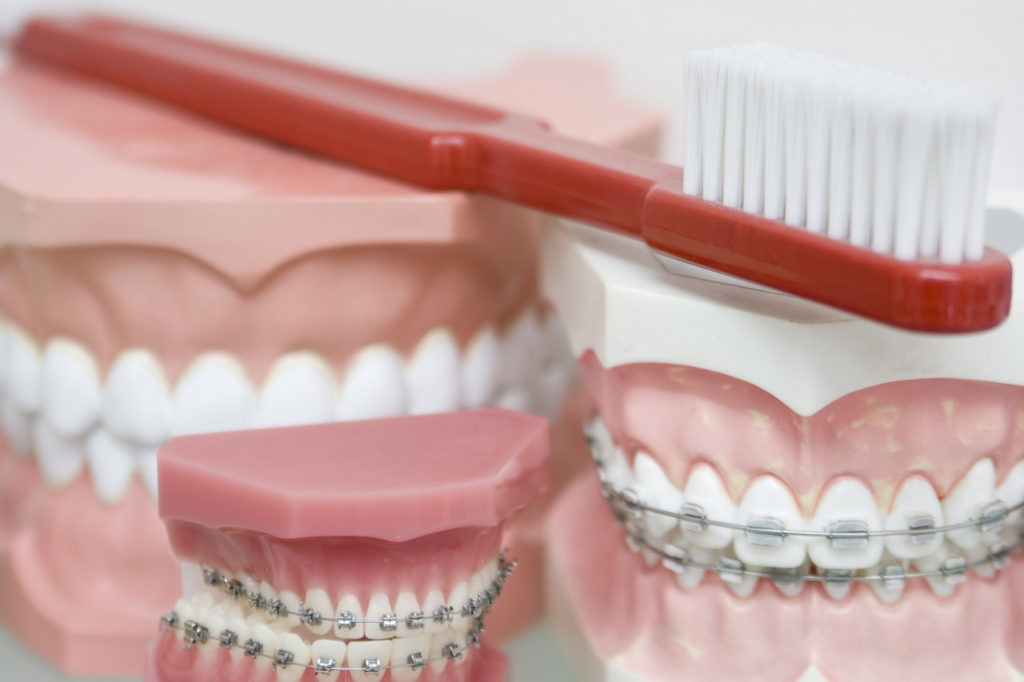
Does your child need braces? If they do, you’re probably wondering what their options are and what the best kind of braces are for your child.
Are traditional metal braces the best kind for a kid? Will they feel self-conscious? What about clear aligners?
You and your child both probably have questions about the different kinds of braces and what to expect. Your orthodontist will walk you through the different options, but here are some choices they might recommend for your child.
Traditional Braces
These are the kind of braces most parents envision when they think of the word braces.
Traditional metal braces will straighten your child’s teeth using brackets and archwires. This style of braces relies on the archwires to create pressure and gently move the teeth into place over time.
Metal braces also use bands and ties that come in a variety of colors. Your child might have fun choosing the colors for their metal braces and personalizing the look a little.
Traditional braces are also quite durable, more so than ceramic braces. This can be a definite plus for children that gravitate towards sticky or hard foods, even if these are foods your child should avoid.
One con of traditional braces is that they’re visible and can make some children self-conscious about their appearance. However, braces can be fun, and children may enjoy customizing the color of the bands when they go in for adjustments.
One more factor to note is that metal braces can cause some irritation, especially when they’re first placed on the teeth. The brackets can irritate the gums or cheeks, though orthodontic wax helps.
Ceramic Braces
While ceramic braces also use archwires and brackets, they’re less noticeable. The brackets on ceramic braces are a lighter color, such as clear or the color of your child’s teeth. This makes ceramic braces one of the better braces for children that might feel self-conscious.
They are a little less durable than metal braces, and they may stain. Proper cleaning is crucial if your child wants to keep their ceramic braces from staining. Many orthodontists recommend this style of braces for children that aren’t great candidates for clear aligners.
All braces can help boost your child’s confidence by straightening their teeth, but ceramic braces might help them feel more confident as they’re not as visible.
Clear Aligners
Many people think of adults getting clear aligners as an alternative to traditional braces, but they may make a good choice for your child, too!
Aligners are far less noticeable compared to traditional braces. They are designed to be removed so that you can eat and clean them. These aligners gradually move the teeth into position.
Removable aligners make it easy for your child to brush their teeth and floss. Another benefit is that this style is less irritating and more comfortable for children.
Of course, the biggest downside to aligners is that your child needs to wear them as instructed. Children that won’t put their aligners back in after eating or brushing their teeth won’t benefit as well. Also, this may not be a good option for children that tend to forget things as they may lose their aligners.
Talk to your orthodontist about whether your child is a candidate for clear aligners. Depending on the state of their teeth and jaw, this may not be the best option for them.
Self-Ligating Braces
This type uses archwires and brackets, similar to traditional braces, but there are no bands. Instead, self-ligating braces guide the teeth into place using clips.
This style of braces can be more comfortable, as there isn’t the pressure associated with traditional braces. Patients may also find it easier to keep their teeth clean.
These types of braces are still visible, but clear brackets are an option. The brackets are also smaller, which can make them more comfortable for the patient. Additionally, this is a durable style for your child.
Lingual Braces
Lingual braces are placed on the back of your child’s teeth. They have the same parts as traditional braces, but due to their location, this style is almost invisible. This might make them a great choice for children and teens that worry about how they’ll look with braces.
Not every child is a candidate for lingual braces. Those with deep overbites may not qualify for this style, for instance.
Some patients have trouble with their speech after getting lingual braces. This is because the tongue touches the back of the teeth to make certain sounds. However, it’s possible to correct a lingual lisp.
One thing to consider is that, due to their location, there may be an issue with irritation. Patients may experience some discomfort with this style, although customized brackets can help lessen discomfort.
Again, speak with your orthodontist about the best style for your child.
What Are the Best Kind of Braces for Children?
Now that you know more about the various types of braces, you’re likely wondering what your child’s orthodontist will recommend. This depends on several factors, such as the state of their teeth and jaw. Every child’s situation is different.
Your pediatric orthodontist will tell you what kind of teeth need braces, whether your child is a candidate for certain types, and which style is best for your child.
It all depends on their situation. Braces have come so far in recent years that they’re far more comfortable and advanced than they used to be.
Your pediatric orthodontist may also suggest other treatments to fit your child’s needs.
Help Your Child Smile Brighter
Now that you know the different braces out there, you can schedule an appointment with your child’s orthodontist and get a consultation. Your pediatric orthodontist will tell you the best kind of braces for your child.
You can trust Children’s Dental & Orthodontics for all your braces needs and information. Send us a message to set up an appointment and give your child a healthier, brighter smile today!
 (214) 453-2565
(214) 453-2565